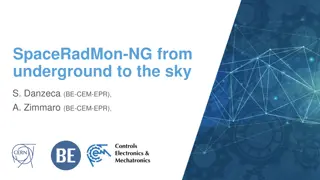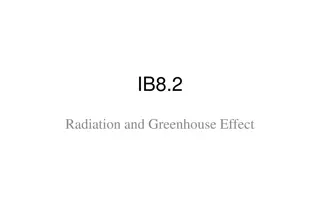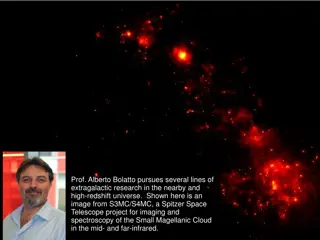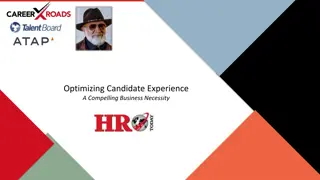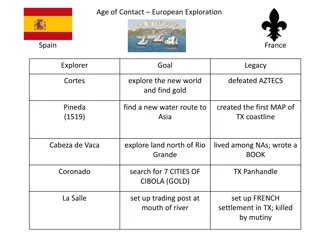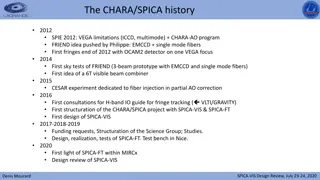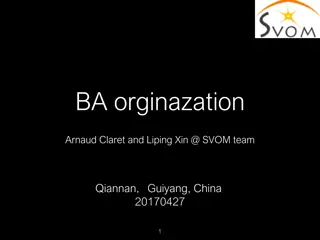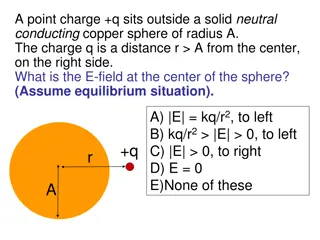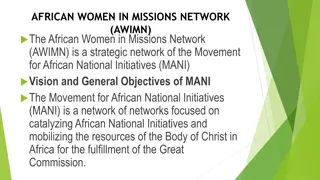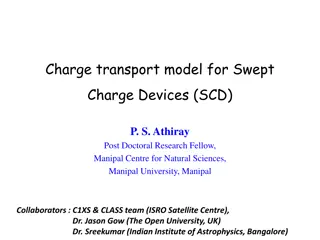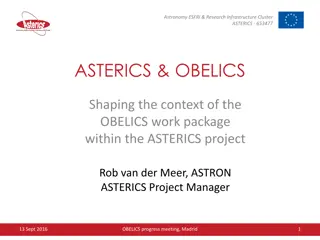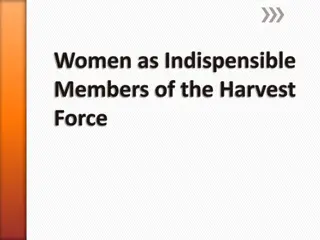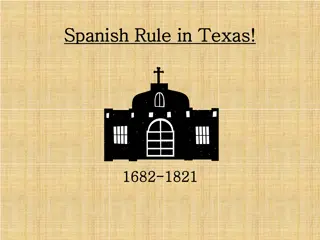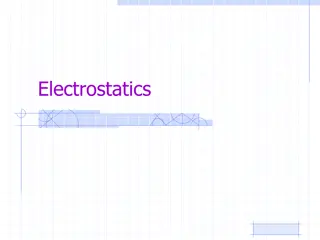Charge to PAGs on Candidate Large Astrophysics Missions
Solicit community input on candidate large missions for NASA to study, providing information for Decadal Survey consideration. Identify mission concepts from previous surveys for study. Limit mission studies due to funding constraints, consider cross-PAG interests, and use various methods to obtain community input.
Download Presentation

Please find below an Image/Link to download the presentation.
The content on the website is provided AS IS for your information and personal use only. It may not be sold, licensed, or shared on other websites without obtaining consent from the author.If you encounter any issues during the download, it is possible that the publisher has removed the file from their server.
You are allowed to download the files provided on this website for personal or commercial use, subject to the condition that they are used lawfully. All files are the property of their respective owners.
The content on the website is provided AS IS for your information and personal use only. It may not be sold, licensed, or shared on other websites without obtaining consent from the author.
E N D
Presentation Transcript
COPAG Response to Hertz: Candidate Large Astrophysics Missions Charge And Exploring the Synergies of a Joint ExoPlanet / UVOIR Mission Mary Beth Kaiser on behalf of the COPAG EC
COPAG Response to Hertz Charge The Charge to the PAGs: Solicit community input on which candidate large missions should be studied by NASA to enable providing sufficient information for the consideration of these missions by the 2020 Decadal Survey Committee The Overall Process: Part A: Identification of a small set of candidate large missions Part B: Develop the science case & technical information for each candidate mission. This will include a STDT for each, but the detailed process TBD by NASA and not the focus of this charge. Part A: Identification of Candidate Mission Concepts for Study Drawn by NASA from the 2010 Decadal Survey New Worlds New Horizons (NWNH) & 2014 Visionary Roadmap, Enduring Quests, Daring Visions Far-IR Surveyor Visionary Roadmap Habitable-Exoplanet Imaging Mission 2010 Decadal Survey UV/Optical/IR Surveyor - 2010 Decadal Survey & Visionary Roadmap X-Ray Surveyor -- Visionary Roadmap 6/25/1 5 UV-Vis Path Forward Workshop 2
COPAG Response to Hertz Charge The Process Identification of a small number of candidate missions Limited money for mission studies. Identification of an additional candidate mission for study, probably results in the exclusion of a study for one of the 4 candidates identified in NWNW and/or the Visionary Roadmap. Considerable EC early discussion about How to solicit community input to ensure breadth and inclusiveness The number of potential missions that could emerge Joint PAG-EC face-to-face meeting Share white papers Plan to identify common (and divergent) viewpoints/ findings Addressed incorporation of common response section in each PAG s report to Hertz (if there are areas of commonality) Encourage cross-participation of EC members in upcoming PAG / SIG meetings Probes - is there cross-PAG support for including a footnote expressing interest in future pursuit of this mission class ? Recognition of Cross-PAG interests X-Ray Surveyor could inform on first SMBHs in first galaxies UV/Optical/IR Surveyor potentially synergistic with the Habitable-Exoplanet Imaging Mission 6/25/1 5 UV-Vis Path Forward Workshop 3
COPAG Response to Hertz Charge The Process Methods Used to Obtain Community Input: Cosmic Origins Website http://cor.gsfc.nasa.gov/copag/rfi/copag-rfi.php AAS Session Cosmic Origins UV-Vis and FIR sessions (Jan 4) ExoPAG/COPAG Joint Meeting (Jan 4) Joint PAG Session (Jan 7) NASA Town Hall Meeting (Jan 7) Cross-PAG telecon and Joint PAG meetings COPAG Virtual Town Hall (Mar 10) White Papers (posted at above COR url & on SIG2 webpages) Science Interest Group (SIG) Meetings 6/25/1 5 UV-Vis Path Forward Workshop 4
COPAG Virtual Town Hall 60 + Participants Agenda: - Overview of Charge - Description of COPAG plans - Discussion Path Forward: - Active solicitation of white papers - SIG meetings - FIR community: FIR-Surveyor Mission Concept - UV-Vis community: UVOIR Mission concepts and synergy with ExoPAG Mission Further Town Hall(s) summarize findings to date & solicit community response date TBD 6/25/1 5 UV-Vis Path Forward Workshop 5
White Paper Solicitation and Response White Paper Proposed Content Format: 1 2 pages - Key Science Question(s) - Technical Capabilities Required - Compatibility with one of the 4 (starting point) candidate Large Mission Concepts for study - New Technologies - Large Mission Needed ? White Paper Response - 34 white papers submitted (http://cor.gsfc.nasa.gov/copag/rfi/copag-rfi.php) - Scope: - 9 papers on FIR Surveyor - 18 papers on UV/O/IR Surveyor - 4 papers on Habitable Exoplanet Imager - 1 paper on X-ray Surveyor - 1 paper on Gravitational Wave mission - 2+ papers on process - Considerable overlap within the FIR and UVOIR technical concepts 6/25/1 5 UV-Vis Path Forward Workshop 6
COPAG Preliminary Findings on Candidate Large Missions Strong Community Support presented to the EC for the four Candidate Missions Identified in the 2010 Decadal Survey and the Visionary Roadmap - Far IR Surveyor - Habitable Exoplanet - UV/Optical/IR Surveyor - X-Ray Surveyor COPAG EC findings are subject to NASA boundary conditions. Given those conditions, evidence for broad COR community support for alternate missions was not presented to the COPAG EC COPAG EC finds strong support for the 4 candidate missions drawn by NASA from the 2010 Decadal Survey and the Visionary Roadmap. Cross-PAG Preliminary Findings on Candidate Large Missions Candidate Missions have cross-PAG science applications and synergies Does this Synergy extend to combining Mission Concepts (e.g. HabEx and UVOIR) ? Community input: WPs will be part of the final report & a valuable reference for Science & Technology Definition Teams (STDTs) charged with development of detailed science requirements for engineering studies. 6/25/1 5 UV-Vis Path Forward Workshop 7
COPAG Preliminary Finding on Probe Class Missions Certain fundamental science questions can be effectively pursued with a probe class mission. Members of the astrophysics community whose science requires a probe class mission have expressed interest in a similar exercise. Multiple unsolicited questions / inquiries were received regarding Probe Class Missions while soliciting input regarding Large Mission Candidates. Indicating that the broader astrophysical community is interested in knowing that Probe class opportunities will be considered in the 2020 Decadal Survey. COPAG Schedule for Report Completion July 2015: Report draft written Last minute inputs due by July 15 ! August 2015: Report review at IAU splinter meeting Fall/ October 2015: Final report presented to Hertz and the Astrophysics Subcommittee 6/25/1 5 UV-Vis Path Forward Workshop 8
HabEx and UVOIR -- How much synergy is there really? Candidate Missions have cross-PAG science applications and synergies Does this Synergy extend to combining Mission Concepts (e.g. HabEx and UVOIR) ? Focus on the science requirements for Exoplanets and UVOIR Astrophysics - What are the key technology requirements to achieve these goals? - Are these technologies compatible with the requirements for the other mission ? Does a large class space telescope enable science synergies with the 30-40 m class ground based telescopes operating in the 2020 - 2030 era? To the extent possible, the HabEx and general UVOIR astrophysics communities in this decade should consider and discuss the science synergies between the next generation space & ground-based telescopes. 6/25/1 5 UV-Vis Path Forward Workshop 9
HabEx and UVOIR - Science synergy questions Size: What science synergies does a large space telescope enable with the 30-40 m class ground-based telescopes operating in the 2020 - 2030 era? What are the key science drivers for telescope size? Bandpass: What COR science requires the 912 3000 Angstrom bandpass ? - What exoplanet science is enabled by the FUV (NUV) bandpass? Optimization wavelength: At what wavelength should the telescope be optimized? Diffraction limited at 300 nm (?), 500 nm (?), 800 (nm) ? Ultra-precise wavefront control: What COR science is enabled through this capability? Instrument Optimization - Imagers What suite best maximizes the COR science return ? What suite best maximizes the Exoplanet science return ? - - Instrument Optimization - Spectrographs What suite best maximizes the COR science return ? What suite best maximizes the Exoplanet science return ? What exoplanet science is enabled by a high(er) resolution spectrograph ? - - - 6/25/1 5 UV-Vis Path Forward Workshop 10
HabEx and UVOIR -- Expanding the synergy HabEx Notional Mission UVOIR Notional Mission Mirror: 4 8 m Monolith Contrast: ~10-10 Coronograph bandpass: 0.5 < < 1.0 m Starshade bandpass: 0.25 < < 1.0 m Starshade bandpass (?): 90 nm < < 1.8 m (1.8 m => strengthen O2, O3 biosignature origin claim) FOV: 1 arcsec Imaging Camera Spectrograph: IFU, R = 70 spectrum of a 30 mag exoplanet Orbit: L2 or Earth trailing Optimized for exoplanets, but other uses of instruments possible Mirror: 8 -16 m, segmented, obscured primary Contrast: ~10-10 for planet imaging, otherwise less Bandpass: ~0.100 < < ~2.0 m (i.e. HST- like) Bandpass: 90 nm < < 2.0 m FUV enabled Instrument Suite: Internal coronagraph: IFU, 400 nm < < 2 m, FOV 10 , 35 milliarsec inner working angle UV: IFU spectrometer 90 < < 300 nm, FOV 1 -3 R< 100,000 Visible: 300 nm < < 1 m, FOV: 6 NIR imger & spectrograph: 1 m < < 2 m, FOV 4 Multi-obj spectrograph 300 nm < < 1 m, FOV 6 Orbit: L2 Temperature: Non-cryogenic; 250-295 K 6/25/1 5 UV-Vis Path Forward Workshop 11
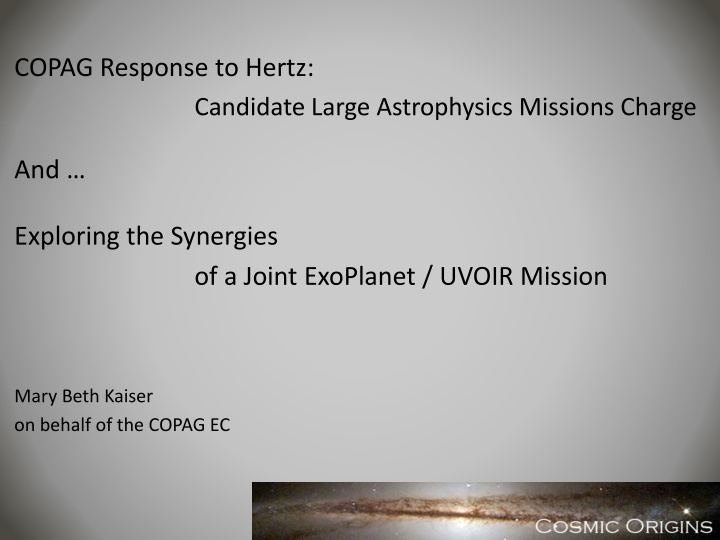

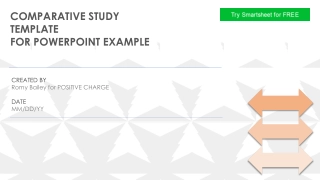
![[PDF⚡READ❤ONLINE] Black Hole Astrophysics: The Engine Paradigm (Springer Praxis](/thumb/21503/pdf-read-online-black-hole-astrophysics-the-engine-paradigm-springer-praxis.jpg)

![[PDF⚡READ❤ONLINE] Cosmology and Particle Astrophysics (Wiley-Praxis Series in As](/thumb/21627/pdf-read-online-cosmology-and-particle-astrophysics-wiley-praxis-series-in-as.jpg)
